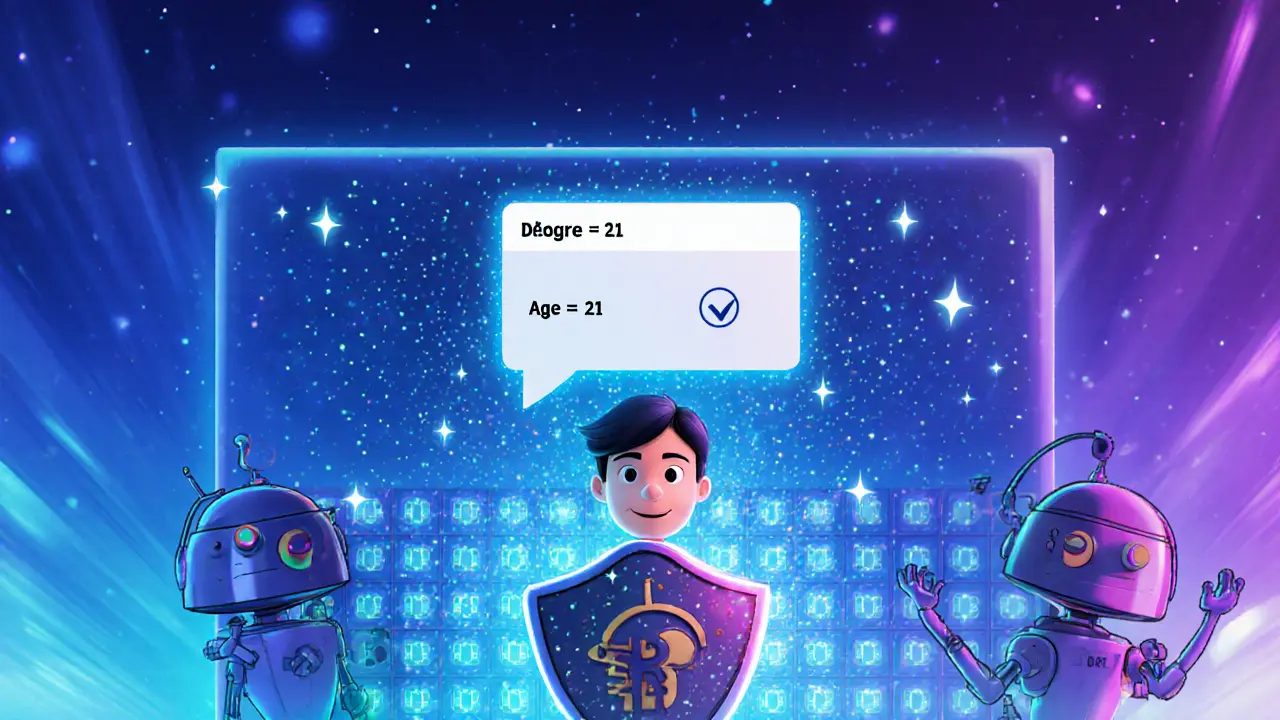 Nov, 2 2024
Nov, 2 2024
Privacy Impact Calculator
Verify Your Data Exposure
Select what you need to verify and see how much personal data is exposed in traditional versus privacy-preserving verification.
Verification Comparison
Data Exposure: 100%
Data Exposure: 10%
How It Works
Traditional Approach
- Full ID document shared
- Full name and address visible
- Birthdate fully exposed
- Photo of ID visible
High risk of data breaches
Privacy-Preserving Approach
- Only required attribute shown
- Selective disclosure of needed info
- Zero-knowledge proof generated
- No raw personal data exposed
GDPR/CCPA compliant
Every time you sign up for a service, you hand over a chunk of personal data - name, address, birthdate, even a photo of your ID. Most platforms store that info in big, centralized databases that are prime targets for hackers. Privacy-preserving identity verification flips that model on its head: you prove the facts you need to share without ever exposing the underlying data. The result is a smoother checkout, a safer KYC process, and peace of mind for users who value privacy.
Why Traditional Verification Falls Short
Conventional identity checks rely on a single authority that collects, stores, and validates your documents. This approach creates two major problems:
- Data overexposure: The verifier sees more than it needs - often the full birthdate, full address, and a copy of your passport.
- Single point of failure: A breach at the central repository compromises millions of records in one go.
Regulators such as the GDPR and CCPA demand data minimization - collect only what you truly need. Traditional systems struggle to meet that requirement without adding friction for users.
Core Technologies Behind Privacy‑Preserving Verification
Modern solutions combine several cryptographic building blocks. Each piece tackles a specific privacy gap while the whole stack runs on blockchain or other decentralized ledgers for tamper‑evidence.
Zero-Knowledge Proofs are cryptographic protocols that let a prover demonstrate the truth of a statement without revealing any additional information. Imagine proving you’re over 21 without showing your exact birthdate. ZKPs generate a short proof that the age condition holds, and the verifier can validate it instantly.
Decentralized Identifiers are self‑owned, globally unique identifiers stored on a distributed ledger, allowing individuals to control their own identity data. Unlike a username tied to a provider, a DID lives in a user’s wallet, and the holder decides which credentials to present.
Selective Disclosure is a feature that enables users to share only the specific attributes required for a transaction, keeping the rest hidden. A driver‑license credential can expose just the “valid license” flag while hiding name, address, and photo.
Secure Multi‑Party Computation is a set of techniques that let multiple parties compute a function over their inputs without revealing those inputs to each other. SMPC can verify that two parties are from the same jurisdiction without revealing the exact location.
How the Flow Works in Practice
- **User creates a DID** on a blockchain wallet and stores verifiable credentials (e.g., passport, driver’s license) encrypted locally.
- **Verifier requests specific attributes**, such as “age ≥ 18” or “citizen of EU”.
- **User builds a zero‑knowledge proof** that the requested condition holds, using the encrypted credential as input.
- **Proof is sent to the verifier**, which checks its validity against public parameters recorded on the ledger.
- If the proof passes, the verifier grants access; otherwise, it denies the request without ever seeing the raw data.
This process satisfies data minimization, gives the user full control, and leaves an immutable audit trail on the blockchain.
Regulatory Alignment: GDPR, CCPA, and Beyond
Privacy‑preserving verification directly addresses the key GDPR principles:
- Purpose limitation: Only the required attribute is disclosed.
- Data minimization: No excess personal data leaves the user’s device.
- Accountability: The blockchain ledger provides tamper‑proof logs for audit.
CCPA’s “right to know” and “right to delete” are also easier to honor because the verifier never stores the raw personal data - only the proof, which can be revoked instantly.

Real‑World Use Cases
Industries are already adopting these methods:
- Banking & FinTech: KYC/AML checks that confirm identity and residency without exposing full passports, reducing fraud and compliance costs.
- Travel & Transportation: Airport security can verify that a traveler holds a valid visa without reading the passport’s full details, speeding up boarding.
- Healthcare: Telemedicine platforms confirm patient age and insurance eligibility while keeping medical records private.
- Ride‑Sharing: Drivers prove they have a clean driving record without sharing their entire DMV file.
Traditional vs. Privacy‑Preserving Verification
| Aspect | Traditional | Privacy‑Preserving |
|---|---|---|
| Data Exposure | Full personal documents transmitted and stored | Only proofs of required attributes |
| User Control | Limited - provider decides storage policy | Full control via DID wallets and selective disclosure |
| Regulatory Fit | Often non‑compliant without costly redesigns | Built‑in GDPR/CCPA compliance |
| Scalability | Central servers can become bottlenecks | Decentralized verification scales with blockchain nodes |
| Typical Use Cases | Online account sign‑up, loan applications | KYC/AML, travel clearance, telehealth, IoT device onboarding |
Implementation Challenges and Best Practices
Deploying privacy‑preserving systems isn’t a plug‑and‑play task. Teams should watch for these common hurdles:
- Computational Overhead: Zero‑knowledge proof generation can be CPU‑intensive. Choose efficient zk‑SNARKs or zk‑STARKs tailored to your use case.
- Key Management: Users must safeguard their DID private keys. Offer hardware wallet support or secure enclave storage on mobile devices.
- Interoperability: Different credential standards (W3C VC, OpenID Connect) need mapping layers. Stick to widely adopted schemas.
- User Experience: Proof generation should happen in seconds. Provide clear status messages and fallback flows.
Best practice checklist:
- Adopt W3C Verifiable Credentials format for all attestations.
- Publish public parameters for ZKPs on a transparent, immutable ledger.
- Implement revocation lists via Merkle trees to allow credential invalidation.
- Conduct a privacy impact assessment (PIA) before launch.
- Run load tests with realistic proof sizes to size infrastructure.

Future Trends: Differential Privacy, Homomorphic Encryption, and Beyond
While ZKPs, DIDs, and SMPC form the foundation, research is pushing the envelope further:
- Differential Privacy: Adds calibrated noise to aggregated verification data, enabling analytics without exposing individual traits.
- Fully Homomorphic Encryption (FHE): Allows computation on encrypted credentials, opening doors to on‑chain eligibility checks that never decrypt data.
- Layer‑2 Scaling: Rollups and sidechains reduce proof verification latency, making mobile verification seamless.
These advancements aim to cut the remaining performance gaps, making privacy‑preserving ID verification as fast as a password check.
Quick Takeaways
- Privacy‑preserving verification lets you prove what’s needed without handing over the whole story.
- Zero‑knowledge proofs, DIDs, selective disclosure, and SMPC are the core tech stack.
- The model aligns naturally with GDPR/CCPA, reducing compliance risk.
- Real‑world adopters span finance, travel, health, and mobility.
- Implementation demands careful key handling, performance tuning, and UI focus.
Frequently Asked Questions
What is a zero‑knowledge proof and how does it keep data private?
A zero‑knowledge proof is a cryptographic protocol where one party (the prover) convinces another (the verifier) that a statement is true without revealing the underlying data. The prover creates a short mathematical proof that can be checked quickly. Because the verifier never sees the raw inputs - only the proof - personal details stay hidden.
How do decentralized identifiers differ from traditional usernames?
A DID is a globally unique identifier recorded on a blockchain, owned and managed by the holder rather than a service provider. It points to a DID Document that lists public keys and service endpoints. Unlike a username tied to a single platform, a DID can be used across many applications, and the holder decides what credentials to associate with it.
Can privacy‑preserving verification be used for KYC in banking?
Yes. Banks can request proofs of age, nationality, and anti‑money‑laundering checks without ever storing the customer’s passport scan. The zero‑knowledge proof satisfies regulator‑mandated verification while dramatically lowering data breach risk.
What are the performance drawbacks of zero‑knowledge proofs?
Generating a proof can require significant CPU cycles, especially for large statements. Verification is usually lightweight, but proof size can affect network bandwidth. Newer zk‑SNARKs and zk‑STARKs have reduced both generation time and proof size, making them viable for mobile devices.
How does selective disclosure improve user privacy?
Selective disclosure lets a user reveal only the exact attribute a verifier asks for - for example, a "valid driver’s license" flag - while hiding name, address, and photo. This minimizes the data surface and prevents downstream services from building a profile based on unnecessary details.
Scott McCalman
November 2, 2024 AT 14:21Alright folks, strap in because the future of ID verification is literally already here – blockchain plus zero‑knowledge proofs is the ultimate privacy hack! 😎
PRIYA KUMARI
November 2, 2024 AT 14:24This whole hype train ignores the brutal reality: most of these solutions are still untested at scale and the math is way over‑engineered. You’re not solving data breaches; you’re just moving the attack surface onto wallets that users can’t protect. Bottom line: the tech is impressive, but the risk profile is still terrifying.
Jessica Pence
November 2, 2024 AT 14:28Great overview! Just a quick note – the term is "verifiable credentials" (VCs), not "credentiales". Also, remember that ZK‑SNARKs need a trusted setup, which can be a point of contention. Overall, this is solid info for anyone getting started.
johnny garcia
November 2, 2024 AT 14:31One might contemplate the epistemological ramifications of delegating trust to immutable ledgers; indeed, the ontology of identity undergoes a paradigm shift. Yet, pragmatically, the user experience must remain frictionless – otherwise adoption falters. 🤔
Andrew Smith
November 2, 2024 AT 14:34Super exciting stuff! I love how this actually puts the power back in users' hands. If it scales, we’ll finally see a win‑win for privacy and compliance.
Ryan Comers
November 2, 2024 AT 14:38Honestly, this is just another Silicon Valley buzzword parade. We’re glorifying crypto while ignoring the fact that governments will still find ways to force backdoors. 🇺🇸
Prerna Sahrawat
November 2, 2024 AT 14:43Permit me, if you will, to indulge in a brief excursus on the philosophical underpinnings of decentralized identity. The very notion of a self‑sovereign identifier is a radical departure from the Hobbesian social contract wherein the sovereign-be it a state or a corporation-exercises unilateral authority over the individual's data. By vesting agency in cryptographic keys, we are not merely engineering a technical solution; we are enacting a sociopolitical manifesto that challenges entrenched hierarchies. Moreover, the deployment of zero‑knowledge proofs serves as a micro‑cosm of epistemic humility: it acknowledges that truth can be demonstrated without exhaustive revelation. This, in turn, dovetails with the GDPR’s principle of data minimization, transforming legal compliance into an ethical imperative. Yet, one must not be naïve; the computational overhead attendant to zk‑SNARK generation is non‑trivial, demanding optimized circuits and, occasionally, trusted setups that re‑introduce points of centralization. Furthermore, the user experience must be sculpted with care, lest the very users we seek to empower be alienated by opaque wallet interfaces. In sum, while the architecture is elegant, its successful adoption hinges upon a harmonious confluence of legal scholarship, UI/UX craftsmanship, and rigorous cryptographic engineering. Only then can we hope to realize the lofty promise of privacy‑preserving identity without succumbing to the siren song of techno‑utopianism.
Joy Garcia
November 2, 2024 AT 14:46Sounds great until you realize the shadow agencies will simply request a court order to pull your wallet keys. Then everything collapses like a house of cards built on conspiracy.
mike ballard
November 2, 2024 AT 14:49From a cultural diffusion standpoint, this paradigm shift aligns with the broader move toward decentralized autonomous societies. The lexicon of “DID”, “VC”, and “ZKP” is rapidly becoming part of the tech‑savvy vernacular.
Molly van der Schee
November 2, 2024 AT 14:53That’s a thoughtful perspective. It’s reassuring to see the focus on user empowerment while keeping the tech accessible.
Mike Cristobal
November 2, 2024 AT 14:58We must never compromise on moral integrity; building systems that respect privacy is a duty, not a option.
Erik Shear
November 2, 2024 AT 15:01I get where you’re coming from but there’s room for dialogue and compromise.
Tom Glynn
November 2, 2024 AT 15:06Remember, the biggest hurdle is often user education – help them feel confident, and adoption will follow. 🚀
Johanna Hegewald
November 2, 2024 AT 15:09Good points – keep the steps simple and clear for newcomers.
Benjamin Debrick
November 2, 2024 AT 15:14It is, without a shadow of a doubt, the quintessential epitome of contemporary cryptographic innovation; however, one must be wary of the ostensible allure that belies the underlying computational exigencies. Indeed, the latent latency inherent in zk‑SNARK generation can, if left unmitigated, engender a user experience antithetical to mass adoption. Consequently, developers are behooved to deploy optimally curated circuits, lest the system succumb to prohibitive overhead. Moreover, the governance models governing DIDs necessitate robust consensus mechanisms; otherwise, the very fabric of decentralization unravels. Furthermore, the interplay between selective disclosure and regulatory mandates such as GDPR is not merely a technical challenge but a jurisprudential conundrum that demands interdisciplinary dialogue. In light of these considerations, a holistic approach-melding cryptography, law, and human‑centered design-emerges as the singular pathway to genuine, sustainable progress.
Anna Kammerer
November 2, 2024 AT 15:18Oh sure, just sprinkle some buzzwords and call it a day – because that’s how real solutions get built, right? 🙄
Mike GLENN
November 2, 2024 AT 15:21Your enthusiasm is admirable, but let’s dig deeper into the practicalities. First, the wallet recovery process must be foolproof; users lose access otherwise. Second, integration with legacy systems often requires adapters that can nullify the privacy gains. Third, educating end‑users about the nuances of selective disclosure is non‑trivial. Finally, ongoing maintenance of revocation lists adds operational complexity that cannot be ignored.
Shane Lunan
November 2, 2024 AT 15:24Looks cool.